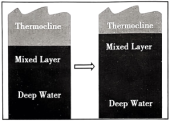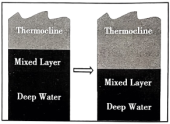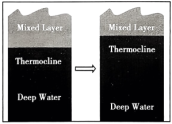1. What is the main topic of the talk?
| A.Energy conservation. |
| B.New housing construction. |
| C.The number of bicycles and cars. |
| A.To keep out the cold. |
| B.To keep other houses warm. |
| C.To avoid being overheated in summer. |
| A.By cutting back on parking. |
| B.By building 24 miles of bicycle paths. |
| C.By encouraging university students to use bicycles. |
| A.To save gas. | B.To relieve traffic jams. | C.To test new energy alternatives. |
2 . As biologist Nicola Foster and her colleagues guided a remote-controlled monitor through the coral reefs (珊瑚礁) of the Indian Ocean’s Chagos Archipelago, they saw corals full of color near the surface. But nearly 300 feet below, in the darker and colder waters of what oceanographers call the “twilight zone,” some corals had turned terrible white, leaving them vulnerable (脆弱的) to disease and death.
“It wasn’t something we were expecting to see,” says Foster, who studies deeperwater coral ecosystems called mesophotic reefs. Mesophotic reefs would seem to be protected from rising sea-surface temperatures that white n higher-up corals. But this team’s 2019 observations show the deepest instance of bleaching (变白) ever recorded — suggesting similar reefs are more vulnerable than previously believed.
Bleaching often happens when warming water boosts corals to remove the colorful algae (水藻) that live in their tissues and help to sustain them. Although surface waters weren’t typically warm when Foster and her team took their measurements, the twilight zone waters neared 84 degrees Fahrenheit (华氏度) — far above the 68-to 75-degree range in which mesophotic corals are used to.
The researchers realized that bleaching is related to the timing of the Indian Ocean Dipole. This phenomenon shifts the region’s surface winds and ocean currents, says study co-author Phil Hosegood. Wind and waves shake the upper ocean, keeping it relatively warm and uniform in temperature. But the 2019 dipole deepened this well-mixed upper layer; the thermocline (the slice of ocean that separates warm upper waters from the cold depths) had become deeper than normal. Then, those corals were exposed to temperatures that are normally found at the surface.
This observation suggests mesophotic reefs elsewhere could also be bleaching. Fortunately, the corals in this study had largely recovered their color by 2022, Foster notes. But each bleaching stresses the corals and, if extended, can starve them. Future Indian Ocean Dipole patterns are likely to be more severe, Hosegood says, noting that data suggest “that these natural cycles are becoming increased with climate change.”
1. What are the first two paragraphs mainly about?| A.Corals in twilight zone become vulnerable because of bleaching. |
| B.Corals normally found at the surface were found in twilight zone. |
| C.Mesophotic reefs are much more vulnerable than higher-up reefs. |
| D.Mesophotic reefs and higher-up reefs need different temperature. |
A. | B. |
C. | D. |
| A.excited | B.worried | C.curious | D.hopeful |
3 . Around the world, coral reefs (珊瑚礁) are in danger. Now, let’s check out a few ways conservationists are protecting these habitats.
Seaweed Smackdown
Hot ocean temperatures can supercharge seaweed growth — and that’s not good for a reef. So, in Hawaii, scientists have used an underwater vacuum (真空吸器) to suck up lots of seaweed into the device’s long tube. In Australia, scientists are studying a low-tech solution: pulling seaweed by hand.
21
Some polyps (珊瑚虫) are harmed by heat waves and pollution. Scientists cut parts of coral from a healthy reef. Then these polyps are taken to a nursery, which could be in shallow protected areas underwater. After about a year, the healthy coral parts are attached to damaged reefs. The nursery-grown corals can bring new life to a struggling habitat.
Sound Saver
Healthy reefs are noisy. Fish make different sounds, and thousands of shrimp create and pop bubbles with their claws to create a sound. The biologists play sounds of healthy reefs through underwater speakers. They found that six weeks of broadcasting healthy reef sounds doubled the amount of fish in the area.
Bleaching Killer
One of the biggest threats to coral reefs is bleaching. Here’s how it works.
| Thriving coral Most coral species survive by partnering with tiny algae (藻类), which make food for the coral by changing sunlight into sugar. |
| Under stress But when the ocean water gets too hot, the algae produce too much oxygen, which can hurt the coral. |
| Bleaching So corals kick out the algae. As the algae leave, the color disappears and the coral appears to turn white. This process is called bleaching. |
Biologists have discovered that many corals in the Red Sea have a species of algae in their tissue that’s found nowhere else, so they can survive heat waves. Biologists hope their work will inspire governments and environmental groups to protect these corals.
1. Which of the following might be the subtitle of Paragraph 3?| A.Underwater Nurseries. | B.Fishing Guides. |
| C.Seaweed Cleaners. | D.Colour Designers. |
| A.Breathing in more oxygen. | B.Changing the appearance. |
| C.Absorbing more sound. | D.Partnering with algae. |
| A.To present the serious damages to corals. | B.To explain the reasons for coral habitat loss. |
| C.To introduce the methods of coral protection. | D.To compare the effects of different solutions. |
4 . Birders get nervous when they see landscapes covered in wind turbines (涡轮机). When the wind gets going, their blades (叶片) can turn around at well over 200km per hour. It is easy to imagine careless birds getting cut into pieces and wind turbines do indeed kill at least some birds. But a new analysis of American data suggests the numbers are negligible, and have little impact on bird populations.
Erik Katovich, an economist at the University of Geneva, made use of the Christmas BirdCount, a citizen-science project run by the National Audubon Society. Volunteers count birds they spot over Christmas, and the society gathers the numbers. He assumed, reasonably, that if wind turbines harmed bird populations, the numbers seen in the Christmas Bird Count would drop in places where new turbines had been built. Combining bird population and species maps with the locations and construction dates of all wind turbines, he found building turbines had no noticeable effect on bird populations.
Instead of limiting his analysis to wind power alone, he also examined oil-and-gas extraction (开采), which has boomed in America over the past couple of decades. Comparing bird populations to the locations of new gas wells revealed an average 15% drop in bird numbers when new wells were drilled, probably due to a combination of noise, air pollution and the disturbance of rivers and ponds that many birds rely upon. When drilling happened in migration centers, feeding grounds or breeding locations, bird numbers instead dropped by 25%.
Wind power, in other words, not only produces far less planet-heating carbon dioxide and methane than do fossil fuels. It appears to be significantly less damaging to wildlife, too. Yet that is not the impression you would get from reading the news. Dr Katovich found 173 stories in major American news media reporting the supposed negative effects that wind turbines had on birds in 2020, compared with only 46 stories discussing the effects of oil-and-gas wells.
1. What does the underlined word“negligible”in paragraph 1 mean?| A.Insignificant. | B.Inaccurate. | C.Inconsistent. | D.Indefinite. |
| A.Previous studies. | B.Relevant data. |
| C.Reasonable prediction. | D.Experiment results. |
| A.Oil-and-gas extraction has expanded in America. |
| B.Birds are heavily dependent on rivers and ponds. |
| C.Many factors lead to the decline of bird populations. |
| D.Well drilling poses a serious threat to birds' survival. |
| A.Wind turbines could share the sky with wildlife. |
| B.More evidence is needed to confirm the finding. |
| C.Wind power will be substituted for fossil fuels. |
| D.Wind turbines deserve wider media coverage. |
5 . A shopkeeper’s son breaks a window, causing a crowd to gather. They tell the shopkeeper not to be angry: actually, the broken window is a reason to celebrate, since it will create work for the glazier (装玻璃的工人). In the story, written by a 19th-century economist, the crowd envisions the work involved in repairing the window, but not that involved in everything else on which the shopkeeper could have spent his money — unseen possibilities that would have brought him greater happiness.
If that window were to be broken these days, people might have a different reaction, especially if they were NIMBYs (Not In My Back Yard) who oppose any local construction that affects their quality of life. Their concern might be with the “embodied carbon”. The production of a piece of glass would carry a sizeable carbon cost. Similarly, the bricks and concrete in a building are relics of past emissions. They are, the logic goes, embodied carbon.
Conserving what already exists, rather than adding to the building stock, will avoid increasing these embodied emissions — or so NIMBYs often suggest. At its worst, this idea is based on a warped logic. Greenhouse gases released by the construction of an existing building will heat the planet whether the building is repaired or knocked down. The emissions have been taken out of the world’s “carbon budget”, so treating them as anew debit means double counting. The right question to ask is whether it is worth using the remaining carbon budget to repair a building or it is better to knock it down.
Choosing between these possibilities requires thinking about the unseen. It used to be said that construction emitted two types of emissions. Besides the embodied sort, there were operational ones from cooling, heating and providing electricity to residents. Around the world, buildings account for 39% of annual emissions, according to the World Green Building Council, of which 28% come from operational carbon.
These two types of emissions might be enough for the architects designing an individual building. But when it comes to broader questions, economists ought also to consider how the placement of buildings affects the manner in which people work, shop and travel. Density (密度) lowers the per-person cost of public transport, and this reduces car use. Research by Green Alliance, a pressure group, suggests that in Britain a policy of “demolish (拆除) and densify” — replacing semi-detached housing near public transport with blocks of flats — would save substantial emissions. Without such demolition, potential residents would typically have to move to the suburbs instead, saving money on rent but consuming more energy.
Targeted subsidies (补贴), especially for research and development into construction materials, could speed up the pace at which the built environment decarbonises. What will never work, however, is allowing the loudest voices to decide how to use land and ignoring the carbon emissions of their would-be neighbours once they are out of sight.
1. The first two paragraphs are written to ________.| A.exemplify an outlook on energy conservation |
| B.present a new way of relieving energy crisis |
| C.explain people’s reaction to a broken window |
| D.introduce an argument on carbon emission |
| A.Unsound. | B.Complicated. | C.Distinctive. | D.Underlying. |
| A.Operational carbon accounts for a larger share of carbon emission. |
| B.Repairing old buildings outweighs demolition in energy conservation. |
| C.Higher residential density near public transport may help reduce emission. |
| D.Stopping residents from living in new buildings is sensible to energy saving. |
| A.Interests of NIMBYs are worthy of consideration. |
| B.A comprehensive insight into emission is essential. |
| C.Upgrading construction materials should be prioritized. |
| D.Every resident should do their bit in reducing carbon emission. |
Chinese achievements in pollution control, ecological recovery and protection, and green development China
According to the press briefing, China has been the fastest in improving air quality and the PM 2.5 level in cities at the prefecture level and above dropped by 34.8 percent from that of 2015. Days with good air quality reached 87.5 percent. Pollution of water bodies and the soil is also
The country has taken
Soil
In an age of rapidly growing urbanization, rooftop farming has emerged as a sustainable response
Rooftop farming, also
As urban populations continue to grow, rooftop farming fosters community engagement
1. What’s the conversation mainly about?
| A.Fighting fire. | B.Detecting fire. | C.Preventing fire. |
| A.Australia lost 4% of its trees. |
| B.The system is used in America. |
| C.The system will use heat cameras. |
| A.The size of a car. | B.The size of a plane. | C.The size of a football field. |
| A.Protecting humans. | B.Purifying the air. | C.Saving animals. |
Imagine you are out fishing on the high seas - the wind and water are clean and comfortable and you begin bringing up your first catch of the day. That's when everything goes wrong. Your fishing nets are tangled up (缠成一团) in older, abandoned fishing tool, and you're unable to untangle them. Your equipment
Ghost fishing is what abandoned fishing tool does. It still catches fish, but no one benefits. Trapped fish die and attract scavengers (清道夫)
Environmental agencies estimate that 10 percent of all seawater litter is lost or deserted fishing tool
It's not the intention of the majority of fishermen to lose their tool. In most circumstances bad weather is to blame. But in other cases fishermen throw their tool in the ocean on purpose, risking expensive fines. But to them, it's worth the risk
By marking tool with electronic tags and utilizing GPS technology, owners are more likely to recover lost tool and less likely to abandon it. Currently, ownership regulations are reportedly very weak. Leading the effort for tagging fishing tool and creating accountability is the GGTI (Global Ghost Tool Initiative).
Ghost fishing poses a serious threat to the fishing industry worldwide, and a global effort is needed to solve it.






